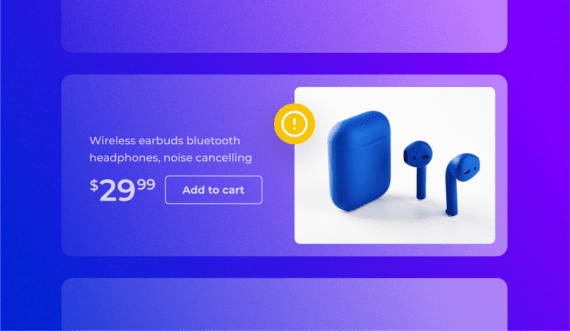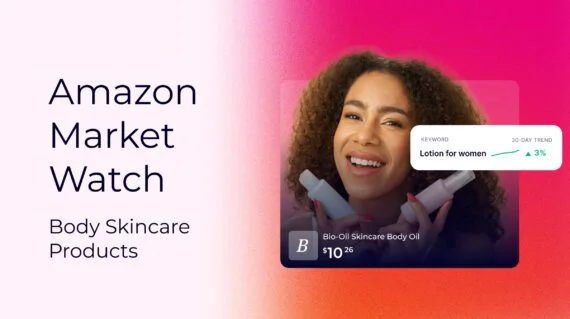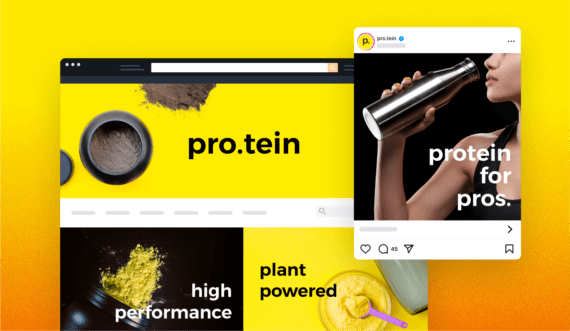Amazon’s massive marketplace is a double-edged sword. Sellers have access to a global customer base and backing from a trusted brand. But competition is intense. You have to strategize and innovate constantly to go toe-to-toe with all the sellers angling for a top spot (aka everyone).
To succeed on Amazon, you can’t just list products. You have to boost your visibility to drive sales, and the best way to do this is through digital marketing. Amazon’s top sellers have well-rounded digital marketing strategies, and you need one, too.
Let’s jump into digital marketing for Amazon and what you can do to increase your chances of success on the ecommerce platform.
Why is digital marketing important for Amazon success?
If you’ve ever done a competitor analysis, you know the Amazon marketplace is fierce. Sellers have to keep a close eye on how competitors are pricing products, where they’re sourcing from, and how they differentiate themselves in the market.
Visibility is everything. Customers can’t buy from your business if they don’t know you exist. Digital marketing is a strategic way to plant your flag in the ground and start showing up in the search results.
Emphasizing the role of Amazon SEO
Did you know that 56% of online shoppers start their product searches on Amazon? So, if someone is on the market for a cordless vacuum for carpet and hardwood flooring, there’s a good chance that they’ll start their search on Amazon! This customer’s search will likely include keywords like, “cordless vacuums,” “cordless vacuums for carpet,” and “cordless vacuums for hardwood.”
Let’s say you sell vacuums on Amazon. If you aren’t including keywords like these in your product listings, your storefront won’t appear in the search results. Showing up on page 50 is also not ideal. Products on the first page get 80% of all clicks, and the first three listings on a page get at least 60% of those clicks.
That’s why SEO is essential for helping your listings stand out. Optimizing your product listings with relevant keywords, improving your product descriptions, and refining your product titles can improve your rankings and drive more traffic.
Amazon’s algorithm works a little differently than Google’s. Amazon focuses on sales velocity and conversion rates, prioritizing conversions over traffic. Oversaturating your listings with keywords won’t improve your rankings and can hurt readability. But product optimization and sales can give you a boost because you’re converting visitors into buyers.
You want to focus on natural, relevant keyword integration to enhance both SEO and conversions. Regularly updating your listings based on keyword trends, performance metrics, and competitor analysis is also important.
Some key metrics to monitor include:
- Revenue per click
- Keyword ranking
- Organic traffic
- CTR
- Sales velocity
Understanding Amazon advertising and its effect on sales
Amazon advertising gives sellers a way to amplify their product presence. The platform offers four primary sponsored ad formats: Sponsored Products, Sponsored Brands, Sponsored Display, and Sponsored TV.
With Sponsored Products, sellers can give individual products a boost and drive immediate sales. Sponsored Products also improve organic search rankings by increasing sales velocity. Among the ad formats, they deliver the highest return on ad spend (ROAS).
Sponsored Brands are banner ads that show up at the top of the search results. You can showcase a range of products and drive traffic straight to your brand store or custom landing page. If you want to establish your brand presence or differentiate your brand from competitors, Sponsored Brands are a wise option. 
No matter the sponsored ad format you choose, targeted ads get your products in front of the right buyers and increase conversions. This is especially important if you’re selling within a competitive product category like Home and Kitchen, Beauty and Personal Care, or Clothing, Shoes, and Jewelry.
Using promotions as a key sales driver
Promotions create a sense of urgency. It’s one of the reasons Amazon sellers run Lightning Deals — limited-time offers motivate shoppers to make quick purchasing decisions.
But there are some drawbacks to Amazon Lightning Deals. They can lower your profit margins and create fulfillment challenges, so they don’t make sense for every seller. Plus, you can’t control the exact date and time of the deal.
At Jungle Scout, we know promotions have to be strategic. We analyze seasonal trends and historical sales data to pinpoint peak shopping periods. We also track keyword trends to highlight surges in product demand.
This market intelligence helps you choose the right promotions. Run your discount or BOGO offer with confidence, knowing your offer will attract new customers and maximize your profits.
Driving social media traffic to your Amazon listings
Nearly half of U.S. consumers say they’ve purchased a product on social media. Platforms like Facebook, Instagram, and TikTok are prime locations to expand your reach and bring in new customers. When shoppers can see products in action, especially through user-generated content (UGC), they’re more likely to make a purchase. Compelling social media content sells!
Paid ads can help you break through the noise on social media and get in front of the right buyers. You can drive traffic directly to your Amazon product page or promotion. To do this, you need high-quality product visuals and solid ad copy with a clear CTA like “Shop Now.” You’ll also want to refine your target audience. With Amazon’s custom audiences, sellers can target specific customer segments based on their shopping history.
Essential components of an Amazon digital marketing strategy
When creating your Amazon digital marketing strategy, these components are your non-negotiables:
Targeted keyword optimization
Consumer search habits and trends evolve constantly. New products and competitors enter the Amazon marketplace every day. Continuous keyword optimization helps sellers stay ahead of shifting search trends and seize new opportunities as they arise.
Tools like Jungle Scout’s Keyword Scout allow you to tap into what shoppers search for on Amazon. You can discover the keywords products rank for, including your competitors. Seeing these data points alongside historical search volume will enable you to optimize your listings and PPC campaigns with the right keywords. 
You’ll also want to closely monitor your keywords to ensure they’re driving traffic to your storefront. Real-time monitoring can help you see the keywords that are performing and underperforming. With a tool like Rank Tracker, you can track your keyword performance over time and see the rank history for different keywords in one place. It shows you which keywords you might need to toss out and which ones you should focus on. 
Audience targeting and segmentation
Knowing who’s buying your products is vital. Audience targeting connects sellers with buyers looking for products like theirs. In September 2024 alone, Amazon attracted 3.09 billion visitors to its site, so discernment is key.
When you target specific audience segments, you can create Amazon ads that resonate with your potential customers. Targeting also allows you to use your advertising budget more efficiently. Focus on your most promising customer segments rather than going for non-targeted audiences.
Tailored ads offer a better shopping experience because potential customers see the products they’re more likely to buy. That means higher click-through and conversion rates!
Competitor monitoring and analysis
Staying a step ahead of your competitors requires some proactive sleuthing. You’ll want to find out what marketing strategies they’re using. What social media platforms are they most active on and what do they post? Do they send out email marketing campaigns?
Find out how they’re pricing products and what keywords drive shoppers to their product detail pages. You’re bound to find gaps and opportunities to outperform your competitors, and Jungle Scout’s Competitive Intelligence Tool can help you identify them. It reveals how Amazon’s top sellers dominate the market and gives you strategies for winning back market share — and boosting your bottom line! 
Building a brand presence on Amazon
Shoppers buy from brands they recognize and trust. A well-defined brand helps you stand out from the competition and builds consistency so people know what to expect from your brand.
Sharing your brand story is a great way to connect with potential customers. If a brand is relatable, shoppers are more likely to form an emotional connection. It’s why you see so many brands tugging at consumers’ heartstrings.
Make sure you’re using high-quality images and videos to showcase your products, including lifestyle images of your products in use. Express a clear and consistent brand voice across all your listings, and lean into the unique features and qualities that set your products apart (e.g., quality and craftsmanship).
Paying attention to the right concepts
Your digital marketing strategy should hinge on the specifics of your business, including your audience, market share, and products. But there will come a time when you’ll want to implement a range of digital advertising tactics in your Amazon selling strategy. This might include:
- Social media marketing
- Influencer marketing
- Email marketing
- PPC advertising
- User-generated content
- Search engine optimization (SEO)
- Live streaming
Be open to learning new skills, and don’t be afraid to experiment with new strategies to see what sticks.
6 steps to build an Amazon digital marketing strategy that works
Ready to get down to the brass tacks of creating your digital marketing strategy? Let’s walk through the process step by step.

Step 1: Conduct thorough market and competitor research
Start out by getting the lay of the land. Know what’s going on in the market and what competitors are doing. This will help you spot trends and opportunities to set your business apart.
Competitive intelligence comes in handy when you want to benchmark your position in the market against other key players. Jungle Scout’s Review & Listing Analysis feature sorts through customer reviews from your top competitors, comparing your listings side-by-side, to help you optimize them based on what customers want and need.
Step 2: Define your target audience
Next, determine who wants your products and why. This knowledge is foundational to building a marketing strategy that reaches and engages the right people. Amazon’s built-in analytics tool can provide insights into your shoppers’ demographics, purchase history, and browsing behavior.
Find out what customers are saying about your products by scanning customer reviews and feedback. Social media is another great source for tracking customer sentiment and trends within your industry. You’ll have names and faces you can leverage to influence your marketing strategy.
Step 3: Optimize your product listings for SEO
Make sure your products pop up when shoppers search by optimizing your listings for SEO. Include the right high-performing keywords in your titles and descriptions, along with the backend keywords that improve your visibility and conversions.
If you get stuck, Keyword Scout can help you find high-converting keywords for your listing. Jungle Scout’s Listing Builder can also take the work of writing listings off your plate. It instantly optimizes your listings using AI and offers live feedback on how likely your listings are to rank and convert sales.
Step 4: Create and manage Amazon PPC campaigns
Set up Amazon Pay-Per-Click (PPC) advertising to drive more sales on the platform. Choose the campaign type that best aligns with your primary marketing goal (e.g., Sponsored Products for direct sales and visibility, or Sponsored Display to retarget past customers and expand your reach beyond Amazon).
Use an Amazon keyword tool or a tool like Keyword Scout and set your bids and budget. Be sure to include a mix of broad, phrase, and exact-match keywords. We recommend starting with conservative bids and adjusting them based on performance. You can also use dynamic bidding to automatically adjust your bids based on a shopper’s likelihood to convert.
Step 5: Leverage promotions and discounts
Run promotions and discounts strategically to increase your traffic and conversions. During peak shopping seasons when shoppers are already likely to make a purchase, a special offer can help sweeten the deal.
Step 6: Monitor performance and adjust your strategy regularly
Effective digital marketing doesn’t run on autopilot. It’s important to regularly monitor your performance including your ad spend, SEO rankings, and sales metrics.
Obviously, monitoring and maintaining your campaigns takes time. That’s why many sellers rely on Jungle Scout to provide Amazon-specific insights and recommendations on market dynamics to amplify their revenue. Our Competitive Intelligence feature gives you visibility into performance data, competitor activity, and market trends so you know when and how to capitalize on opportunities.
Create a digital marketing strategy for Amazon that grows with you
There’s a spot for you alongside Amazon’s top sellers. Competition is steep, but if you promote your brand and get more shoppers to view your listings, you can break away from the pack.
As a seller for the world’s largest retailer, you have powerful tools to help grow your business at your disposal. One of them is digital marketing. The other is Jungle Scout.
Jungle Scout unlocks insights and robust market intelligence data on Amazon to make your marketing strategies more effective. Grow your business faster and maximize your profits, knowing every decision you make is backed by market data.









